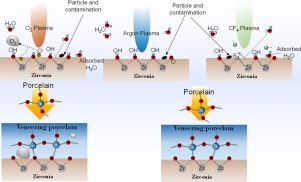Dental Materials ( IF 4.6 ) Pub Date : 2018-05-18 , DOI: 10.1016/j.dental.2018.05.004 Yi-Chuan Liu , Jung-Pei Hsieh , Yung-Chung Chen , Li-Li Kang , Chii-Shyang Hwang , Shu-Fen Chuang

|
Objectives
To evaluate the effects of different atmospheric-pressure plasma (APP) on the physicochemical properties of yttria-stabilized zirconia, and promoting the adhesion of veneering porcelain.
Methods
Cercon base zirconia disks were prepared to receive different treatments: as-polished, three APPs (oxygen, OP; argon, AP; and CF4, CP), and grit-blasted (GB). Their surface roughness and hydrophilicity were measured, and surface morphology was examined either after treatments, after simulated porcelain firing, or additional thermal etching. X-ray photoelectron spectroscopy (XPS) analysis characterized the surface chemical compositions. Shear bond strength (SBS) tests examined the adhesion between veneering porcelain and zirconia either before or after thermocycling. The layered ceramic disks were also sectioned to inspect the porcelain–zirconia interfaces. Statistical analysis was performed with one-way ANOVA and post hoc Duncan’s test.
Results
Grit-blasting caused surface damage and increased roughness. All APP-treated disks exhibited deeper grain boundaries and enlarged grain sizes after thermal etching, while CP disks revealed additional particle dispersions. Three APPs rendered the zirconia surface superhydrophilic. XPS spectra of three APP groups revealed increased hydroxyl groups and reduced C–C contents, and CP group especially showed the existence of Z–F bonds. CP exhibited the highest SBS both before and after thermocycling, while AP and GB also showed improved SBSs compared to the as-polished. OP presented reduced SBS, and its cross-sections showed increased microporosities in the veneering porcelain.
Significance
APP did not change surface morphology but enhanced wettability. CP and AP improved porcelain–zirconia SBSs, primarily through surface hydroxylation. OP induced the microporosities in porcelain and adversely affected the adhesion.
中文翻译:

使用不同的大气压气体等离子体促进瓷-氧化锆键合
目标
评估不同的大气压等离子体(APP)对氧化钇稳定的氧化锆的理化性质的影响,并促进贴面瓷的附着力。
方法
制备基于Cercon的氧化锆圆片以接受不同的处理:抛光后的三个APP(氧气,OP,氩气,AP和CF 4,CP)和喷砂处理(GB)。测量它们的表面粗糙度和亲水性,并在处理后,模拟烧瓷后或另外进行热蚀刻后检查表面形态。X射线光电子能谱(XPS)分析表征了表面化学成分。剪切粘结强度(SBS)测试在热循环之前或之后检查了饰面瓷和氧化锆之间的粘附性。还对分层的陶瓷盘进行了切片,以检查陶瓷-氧化锆界面。使用单向方差分析和事后邓肯检验进行统计分析。
结果
喷砂处理会导致表面损坏并增加粗糙度。在热蚀刻后,所有经APP处理的圆盘均显示出更深的晶界和更大的晶粒尺寸,而CP圆盘则显示出额外的颗粒分散。三个APP使氧化锆表面具有超亲水性。三个APP组的XPS光谱显示羟基增加,CC含量降低,CP组尤其显示Z-F键的存在。CP表现出热循环前后最高的SBS,而AP和GB与抛光后相比也显示出改善的SBS。OP呈现出减少的SBS,其横截面显示出饰面瓷器中微孔的增加。
意义
APP不会改变表面形态,但会增强润湿性。CP和AP主要通过表面羟基化改进了瓷氧化锆SBS。OP引起瓷器中的微孔并不利地影响附着力。











































 京公网安备 11010802027423号
京公网安备 11010802027423号